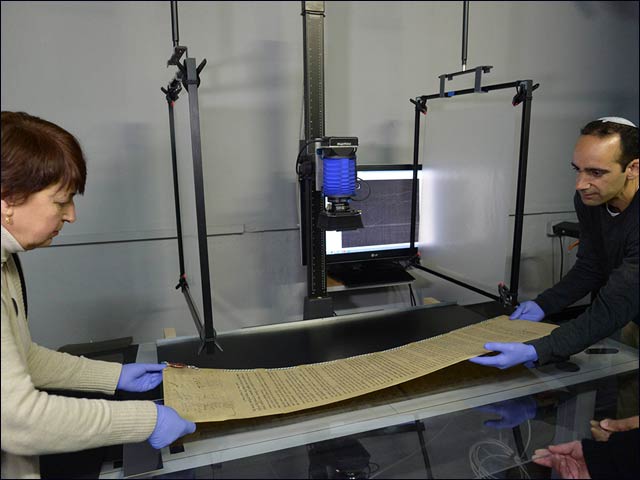(Communicated by the IAA Spokesperson)
In a joint initiative of the
Israel State Archives and
Israel Antiquities Authority, the
Declaration of Independence was removed in a rare event today (Tuesday, 6 January 2015) from the facility where it is stored in a special environment meant to ensure its preservation. The Declaration of Independence – one of the country’s most important cultural assets, which proclaims the establishment of the State of Israel and defines its character – was photographed using innovative technology developed especially for the Dead Sea scrolls, one of the most ancient and important cultural assets of the people of Israel. The photography was done in order to re-create the original appearance of the Declaration of Independence and preserve it for future generations.
The scroll was photographed in the Lunder Dead Sea Scrolls Conservation Laboratory of the Israel Antiquities Authority, using an advanced multi-spectral photographic system that allows shooting different exposures at a number of wavelengths – from the visible region to the near infrared region of the spectrum. The advanced photography will provide information regarding the texture of the material from which the scroll is made, its ink and topography (surface).
The combination of exposures in the visible range will provide a high quality and exact color photograph identical to the Declaration of Independence, while exposures in the near infrared region will allow reading written characters appearing on the document which have faded over time. With this innovative system a precise and clear copy of the Declaration of Independence was created, as it was when originally signed, prior to the ravages of time that are now visible on it.
Besides the advanced documentation, the photography will facilitate assessing the current condition of the Declaration of Independence, and in that way be of assistance in mapping out the necessary measures for preserving the scroll for future generations.
 Re-creating the Declaration of Independence to its original appearance.
Re-creating the Declaration of Independence to its original appearance.
Photo: GPO/Amos Ben GershomDr. Yaacov Lozowick, the State Archivist, noted that “Today the scroll is stored in an environment with special lighting and temperature conditions, in a secure and guarded facility of the Israel State Archives. Until a decision is made regarding how the scroll is to be exhibited to the public, we will continue performing various operations aimed at documenting, revealing and preserving the scroll for future generations. Today’s photography is another step in this process after last year when the archive, with the assistance of the Israel National Heritage – Landmarks program, digitally photographed the scroll in collaboration with Google.”
Pnina Shor, director of the Dead Sea Scrolls Project at the Israel Antiquities Authority, said, "With the unique technology we developed at the Israel Antiquities Authority together with the best scientists in the world, and generous assistance of the Leon Levy and Arcadia Foundations, we are happy to help not only in preserving the material heritage from the distant past but the recent cultural heritage as well. It is exciting and symbolic to document the Declaration of Independence today, one of the cornerstones of the State of Israel, with technology developed specifically for the Dead Sea scrolls - the earliest Hebrew texts, two thousand years old, which were first discovered on the eve of the establishment of the state, at the time when the Declaration of Independence was written."
Dr. Mordechai Naor is a writer and researcher of the history of Israel. In his recently published book "GreatFriday", describing the ceremony proclaiming the state and the preparation of the Declaration of Independence, he presents both well-known and little-known details about the scroll, the writing of which was not completed until the time of the historic ceremony, and the problems that arose during the signing. For example, he mentioned, “Because the ceremony was held in Tel Aviv, some of the signatories were unable to arrive because Jerusalem was under siege, and they signed the scroll only a month later, in “spaces” that were left them specifically for this purpose. He also said, “Because the guest lists have not been found to this day, it is not known exactly who the 300 individuals were that were invited to the ceremony proclaiming the state. One person that was almost not allowed to enter was the designated Minister of Justice Pinchas Rosenblüth (Rosen) who forgot to bring his invitation. It was only after Ze'ev Sherf, Secretary of the Situation Committee, intervened was he permitted to enter and thus was also able to sign the Declaration of Independence.”
The Declaration of Independence is the most important document created in the State of Israel. It constitutes the first document reflecting Jewish sovereignty since the time of the Hasmonean kingdom, and it is probably the first document that reflects a desire for sovereignty achieved by a democratic consensus. Representatives of various political camps in the Yishuv negotiated every idea and word in it until they reached an agreed upon text. The debate continued until close to the signing ceremony itself. The scroll was read as a proclamation of independence, on Friday, the 5th day of Ayar, 5708 (May 14, 1948) in the Tel Aviv Museum then located at 16 Rothschild Street, in the house of the city’s first mayor, Meir Dizengoff. Twenty-five members of the Provisional State Council signed the declaration and twelve others who were in besieged Jerusalem signed it later. The scroll is 117 cm long and 29.7 cm wide. It is made in three parts, and bound on the side with an interwoven thread and a wax seal.